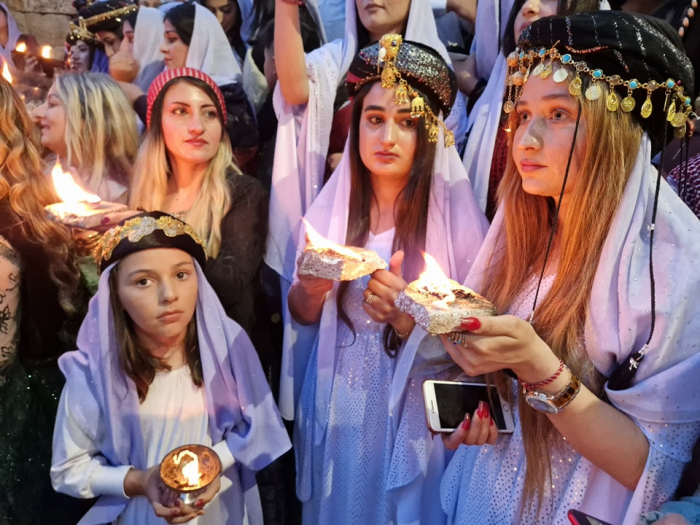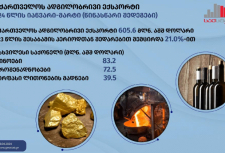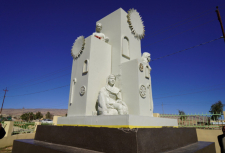Scientists have dispelled the myth of the kinship of Kurds and Yazidis with genetic research - the "National Center for Biotechnological Information" of the USA

The US government's official National Center for Biotechnology Information website has published the results of genetic indicators of Iraq's indigenous people, namely Arabs, Kurds, Assyrians, Turkmen and Yazidis.
Widely considered one of the cradles of human civilization, Mesopotamia is largely located in the Republic of Iraq, which is also home to the Sumerian, Akkadian, Assyrian and Babylonian civilizations. These lands were subsequently ruled by Persians, Greeks, Romans, Arabs, Mongols, Ottomans and finally the British until independence. As a direct consequence of that rich history, the modern Iraqi population is a veritable mosaic of different ethnic groups that include, among others, Arabs, Kurds, Turkmen, Assyrians and Yazidis.
Thus, the genetics of the contemporary Iraqi population is of anthropological and forensic interest. To contribute to a better understanding of the genetic basis of this ethnic diversity, a total of 500 samples were collected from northern Iraqi volunteers belonging to five major ethnic groups, namely: Arabs (n = 102), Kurds (n = 104.)), Turkmen (n = 102), Yazidis (n = 106) and Syrians (n = 86). Y-STR analysis of 17 loci was performed using the AmpFlSTR Yfiler system and then in silico haplogroup assignments were made to gain insight from a molecular anthropological perspective, systematic comparisons were made of the paternal lineages of these five northern Iraqi ethnic groups not only among themselves but also in the context of the broader genetic landscape of the Middle East and beyond using two different genetic distance metrics and accompanying data visualization techniques.
Taken together, the results of the current study suggest complex Y-chromosome lineage patterns among the five ethnic groups analyzed, in which both connectivity and independent microvariation were observed in parallel, albeit in different ways. Notably, the new Y-STR data on Turkmen, Syrians and Yazidis from Northern Iraq represent the first data of this kind in the literature. It is expected that the data presented here will contribute to further demographic and forensic investigations in Northern Iraq in particular and the Middle East in general.
Often considered one of the cradles of human civilization, Mesopotamia encompasses ancient fertile lands defined by the Tigris and Euphrates River systems. Today, these lands are mainly located in Iraq, which borders Jordan to the west, Syria to the northwest, Turkey to the north, Kuwait and Saudi Arabia to the south, and Iran to the east. Iraq has a population of approximately 40 million people, mainly Arabs and Kurds, but also Assyrians, Turkmen, Shabaks, Yazidis, Armenians, Mandeans, Circassians and Qawliya minorities. Accordingly, the population genetics of Iraqis is of interest not only because of this ethnic diversity, but also because the country was home to Sumerian, Akkadian, Assyrian and Babylonian civilizations and was ruled by Persians, Greeks, Arabs, Mongols, Ottomans and Britons.
Scientists have dispelled the myth of Kurdish and Yazidi kinship through genetic research.
Yazidis are genetically closer to Assyrians. Genetics study conducted in Iraq, to find out what modern Iraqi people are closest to the natives of Mesopotamia.
This research has shown that the most genetically close to the ancient population of Mesopotamia are Yazidis and Assyrians, and not Kurds and Arabs. It is Yazidis and Assyrians who are the original inhabitants of Iraq (i.e. the original inhabitants of Mesopotamia, Sumer and Babylon).
Five peoples, Yazidis, Assyrians, Kurds, Arabs and Turkmens participated in the genetic study.
The most common Yazidis haplogroups are R1b (20.79%), L (11.88%) and G2a / J2a1x J2a1b / h (10.89%).
The most common haplogroups among Assyrians are R1b (30.23%), T (17.44%) and J2a1b (15.12%)
The most common haplogroups among the Kurds are J2a1b (20.20%), J1/R1a (17.17%) and E1b1b (13.13%).
The most common haplogroups in Arabs are J1 (38.61%), R1a (12.87%) and T (8.91%).
The most common haplogroups in the Turkmen are E1b1b (17,53%), J1 / J2a1b / R1a (12,37%), and G2a (10,31%).
As we see above Yazidis and Assyrians have the most common haplogroup R1b, with virtually identical haplotypes, while the Kurds have the most common haplogroup J2a1b, and haplogroup R1b is not seen at all among the Kurds.
Another notable fact is that the haplogroup R1b is common not only to Yazidis and Assyrians, but also to the Armenians. What is remarkable is that the territories of the three nations closely border each other.
Also, the UH of the Kurds and Arabs is very high, the Kurds (80.77%) and Arabs (78.83%), and Yazidis and Assyrians by contrast are low, it may show a homogeneity of Yazidis and Assyrians.
In turn, the Kurds logically and cannot be close genetically to the ancient peoples of Mesopotamia, Babylon and Sumer (which this study has shown), as the Iraqi Kurds, and indeed all Kurds came to the territory of modern Iraq, Syria and Turkey through the Zagros mountains in Iran.
Also, the Turkish Kurds mostly came from Iran, and populated Yazidi, Assyrian and Armenian regions in Turkey.
Naturally, if the genetic study of the Kurds of Turkey were made today, it would not differ much from the genome of the Iraqi Kurds, as the most genetically pure Kurds are the Iraqi Kurds, as they recently migrated from Iran to Iraq.
The Turkish Kurds, on the other hand, migrated from Iran to Turkey quite a long time ago. At the same time, the Turkish Kurds assimilated Yazidi, Armenian, Assyrian and other peoples of modern Turkey in large numbers.
*Syrians are meant in the article as Assyrians.
Source: www.ncbi.nlm.nih.gov
Tags: #yazidisinfo #newsyazidis #aboutyazidis
Scientists have dispelled the myth of the kinship of Kurds and Yazidis with genetic research - the "National Center for Biotechnological Information" of the USA

The US government's official National Center for Biotechnology Information website has published the results of genetic indicators of Iraq's indigenous people, namely Arabs, Kurds, Assyrians, Turkmen and Yazidis.
Widely considered one of the cradles of human civilization, Mesopotamia is largely located in the Republic of Iraq, which is also home to the Sumerian, Akkadian, Assyrian and Babylonian civilizations. These lands were subsequently ruled by Persians, Greeks, Romans, Arabs, Mongols, Ottomans and finally the British until independence. As a direct consequence of that rich history, the modern Iraqi population is a veritable mosaic of different ethnic groups that include, among others, Arabs, Kurds, Turkmen, Assyrians and Yazidis.
Thus, the genetics of the contemporary Iraqi population is of anthropological and forensic interest. To contribute to a better understanding of the genetic basis of this ethnic diversity, a total of 500 samples were collected from northern Iraqi volunteers belonging to five major ethnic groups, namely: Arabs (n = 102), Kurds (n = 104.)), Turkmen (n = 102), Yazidis (n = 106) and Syrians (n = 86). Y-STR analysis of 17 loci was performed using the AmpFlSTR Yfiler system and then in silico haplogroup assignments were made to gain insight from a molecular anthropological perspective, systematic comparisons were made of the paternal lineages of these five northern Iraqi ethnic groups not only among themselves but also in the context of the broader genetic landscape of the Middle East and beyond using two different genetic distance metrics and accompanying data visualization techniques.
Taken together, the results of the current study suggest complex Y-chromosome lineage patterns among the five ethnic groups analyzed, in which both connectivity and independent microvariation were observed in parallel, albeit in different ways. Notably, the new Y-STR data on Turkmen, Syrians and Yazidis from Northern Iraq represent the first data of this kind in the literature. It is expected that the data presented here will contribute to further demographic and forensic investigations in Northern Iraq in particular and the Middle East in general.
Often considered one of the cradles of human civilization, Mesopotamia encompasses ancient fertile lands defined by the Tigris and Euphrates River systems. Today, these lands are mainly located in Iraq, which borders Jordan to the west, Syria to the northwest, Turkey to the north, Kuwait and Saudi Arabia to the south, and Iran to the east. Iraq has a population of approximately 40 million people, mainly Arabs and Kurds, but also Assyrians, Turkmen, Shabaks, Yazidis, Armenians, Mandeans, Circassians and Qawliya minorities. Accordingly, the population genetics of Iraqis is of interest not only because of this ethnic diversity, but also because the country was home to Sumerian, Akkadian, Assyrian and Babylonian civilizations and was ruled by Persians, Greeks, Arabs, Mongols, Ottomans and Britons.
Scientists have dispelled the myth of Kurdish and Yazidi kinship through genetic research.
Yazidis are genetically closer to Assyrians. Genetics study conducted in Iraq, to find out what modern Iraqi people are closest to the natives of Mesopotamia.
This research has shown that the most genetically close to the ancient population of Mesopotamia are Yazidis and Assyrians, and not Kurds and Arabs. It is Yazidis and Assyrians who are the original inhabitants of Iraq (i.e. the original inhabitants of Mesopotamia, Sumer and Babylon).
Five peoples, Yazidis, Assyrians, Kurds, Arabs and Turkmens participated in the genetic study.
The most common Yazidis haplogroups are R1b (20.79%), L (11.88%) and G2a / J2a1x J2a1b / h (10.89%).
The most common haplogroups among Assyrians are R1b (30.23%), T (17.44%) and J2a1b (15.12%)
The most common haplogroups among the Kurds are J2a1b (20.20%), J1/R1a (17.17%) and E1b1b (13.13%).
The most common haplogroups in Arabs are J1 (38.61%), R1a (12.87%) and T (8.91%).
The most common haplogroups in the Turkmen are E1b1b (17,53%), J1 / J2a1b / R1a (12,37%), and G2a (10,31%).
As we see above Yazidis and Assyrians have the most common haplogroup R1b, with virtually identical haplotypes, while the Kurds have the most common haplogroup J2a1b, and haplogroup R1b is not seen at all among the Kurds.
Another notable fact is that the haplogroup R1b is common not only to Yazidis and Assyrians, but also to the Armenians. What is remarkable is that the territories of the three nations closely border each other.
Also, the UH of the Kurds and Arabs is very high, the Kurds (80.77%) and Arabs (78.83%), and Yazidis and Assyrians by contrast are low, it may show a homogeneity of Yazidis and Assyrians.
In turn, the Kurds logically and cannot be close genetically to the ancient peoples of Mesopotamia, Babylon and Sumer (which this study has shown), as the Iraqi Kurds, and indeed all Kurds came to the territory of modern Iraq, Syria and Turkey through the Zagros mountains in Iran.
Also, the Turkish Kurds mostly came from Iran, and populated Yazidi, Assyrian and Armenian regions in Turkey.
Naturally, if the genetic study of the Kurds of Turkey were made today, it would not differ much from the genome of the Iraqi Kurds, as the most genetically pure Kurds are the Iraqi Kurds, as they recently migrated from Iran to Iraq.
The Turkish Kurds, on the other hand, migrated from Iran to Turkey quite a long time ago. At the same time, the Turkish Kurds assimilated Yazidi, Armenian, Assyrian and other peoples of modern Turkey in large numbers.
*Syrians are meant in the article as Assyrians.
Source: www.ncbi.nlm.nih.gov
Tags: #yazidisinfo #newsyazidis #aboutyazidis

























